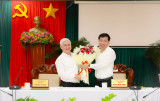Moving forward
In a talk with Binh Duong Newspaper reporter, Mr. Nguyen Minh Duc, the first person to hold the position of Binh Duong provincial Secretary in 1997 recalled the 25-year-old decision on splitting Song Be province to set up the two provinces of Binh Duong and Binh Phuoc. The aspiration for moving forward prompted the then leader of the province to be persistent on the developmental orientation by the mindset of renewing, daring, unifying, and effort making to overcome difficulties for focal leadership, direction and operation to become a marvelous phenomenon of industrialization and modernization.
The foundation of development
- Sir, for the story of the time: the split of Song Be and then Binh Duong province, how did we start the process of construction and development?
- To the last term of Song Be, the central government was still very decisive for the province to organize the provincial congress. At the time, I was the Chairman and Mr. Nguyen Minh Triet (Mr. Sau Phong) was the then Secretary of Song Be provincial Party Committee and now the former State President and member of Politburo. A few months after that, the central government raised up the idea of splitting the province to match the industrialization and modernization at the time. The then Politburo intended to distinguish plain from plain and mountainous areas from mountainous areas – a bid for both provinces to favorably develop. As it was decided, I was designated to the position of Secretary of Binh Duong provincial Party Committee.
Mr. Nguyen Minh Duc said: “My currently greatest expection which is also of the CPV and the people is that the renewing cause will be carried out in stronger deeds by the people, the locality and the nation.” Photo: Quoc Chien
At the time, a provincial Secretary would be at the same time the provincial NA delegate; however and because of focus on the great tasks of a newly established province, I asked not to hold the position of a delegate to NA so that I would be all for local tasks. As the organization was all set, the province immediately entered the replanning which was entirely new in the beforehand tasks of interim step-up of 5-10 years. At the time, the central government highly appreciated such planning as the national and international planning.
The provincial authority, then after the planning was approved by the central government, implemented the planning step by step. The leading matter that the province was targetting at the time was the administration reforms by the regime of one-stop-shop (OSS). Before that was the failed regime of subsidies when all projects were under central government’s management. As Binh Duong was into the new stage, such approach of management was problematic prompting the provincial authority to strongly ask for firstly allocation and then designation all to the local management. Fortunately, the Board of Economic Strategies and Ministry of Planning and Investment had strongly backed such proposals and recommendations. As the matter of fact, the previous projects of 30-40 days of approving window would only need 5-7 days to be approved for implementation. As the central government saw the good implementation as it also limited the corruption; thus, the central government highly appreciated the approach. Then, only OSS was administered in Binh Duong and no other places without any niches. And that was the first time that administrative reforms in Binh Duong had been ranked first in the central government’s listing.
Magical steps forward
- Along with breakthroughs of provincial administrative reforms (PAR), how had the province detail the inudstrial production, sir?
- The province conducted its own planning of its own economic, industrial, agricultural and rural dynamic zones. Therefore, the industrial planning has been gradually and well implemented and developed. Especially, since 1996, Singapore has raised the idea of investing in building the first Vietnam - Singapore Industrial Park (VSIP) in Vietnam with the initial investment direction in the North of the province while the option 2 was in Ho Chi Minh city and option 3 could be decided by the partners. At that time, by monitoring the renovation situation in Binh Duong, especially the breakthrough in PAR in the province, the partner chose Binh Duong to build VSIP I.
The process of building VSIP I, the completely new matter, had also encountered many difficulties as many regulations, mechanisms and policies failed to keep up. For example, the story of the partner's proposal to build a power plant, but at that time, such proposal was unprecedented. Finally, as the province strongly recommended and proposed to the central ministries and branches, the obstacle was removed.
Along with that, the province made the decision to invest in building a new national highway 13. Initially, it was planned that the road would have up to ten lanes, but then, as this was also a new story, no one thought it was necessary to build a road so spacious as there was no car running! That was also the drawback that the province had to face to find ways to solve so that the road was formed. This was also the result of the province's persistent proposal and recommendation. And, National Highway 13 had become a strategic road for Binh Duong to rise step by step.
After only a while, Binh Duong had a miraculous transformation, which was highly appreciated by the Central Committee. At the time, President Tran Duc Luong assessed that Binh Duong's industrialization and modernization was a miraculous phenomenon in the renovation process as no province in the country that had just entered the construction process and redevelopment could be in such a strong economic restructuring towards industrial development. At the time, Binh Duong achieved an industrial proportion of over 60% in the economic structure, which the Central Government considered as the economic restructuring towards an industrial city. Before that, when it was separated, Binh Duong originally started as an agricultural province, but just started to industrialize, the province had a strong economic restructuring towards industrialization as industry accounted for 63%, services over 30%, and agriculture only about 5% in the economic structure. At that time, no other province had ever achieved such an economic structure.
Let no obstacles bar the development
- Sir, in such time of limited policies, how did we solve the problems during the development process?
- In leadership, we resolved whatever in the way. The problems of strategic matters would be resolved partially depending on the support of the central government. The trivial problems of local competent should be solved locally and immediately not to let them bar the way – the process of industrialization and modernization in Binh Duong. From deep down our heart, we thought and raised such matters to the central government for resolution and possible facilitation for Binh Duong to develop.
- After 25 years, how has today’s Binh Duong renewed? What are your expectations for development for the time to come?
- I reckconed that today’s development of Binh Duong had been of size as the nationally leading province of socio-economic development. However, we need to push administrative reforms to stronger acceleration as Binh Duong has not yet lead in this matter in the nation. Thus, we need more comprehensive approach at provincial and district levels to thoroughly remove redtape. My currently greate expectation is that the reforms should be stronger by the good deeds of the Party, the people, the nation and the locality, which is also the great expection of the Party. In macro perspective, whatever barrier of development should be removed and/or adjusted to avoid overlapping. For local perspective, we need to uphold unity to keep getting Binh Duong to stronger development for the time to come.
- Thank you, sir!
Interviewed by Thanh Son – Translated by Vi Bao
 Honoring traditional values, strengthening solidarity
Honoring traditional values, strengthening solidarity
 Igniting, promoting the strength of great national solidarity
Igniting, promoting the strength of great national solidarity
 State President concludes official visit to Peru, attendance at APEC Leaders’ Week
State President concludes official visit to Peru, attendance at APEC Leaders’ Week
 State President’s Chile, Peru trip a success: official
State President’s Chile, Peru trip a success: official
 PM’s trip to bolster Vietnam-Brazil comprehensive partnership
PM’s trip to bolster Vietnam-Brazil comprehensive partnership
 Provincial leader receives Vietnamese Ambassador to Germany
Provincial leader receives Vietnamese Ambassador to Germany
 NA Standing Committee to convene 39th session
NA Standing Committee to convene 39th session
 Focal dirctive and leadership set for success of all-level Party congresses
Focal dirctive and leadership set for success of all-level Party congresses
 Preparations for all-level Party congresses ensure progress under provincial Party Standing Committee's plan
Preparations for all-level Party congresses ensure progress under provincial Party Standing Committee's plan
 Province's development achievements come from the strength of unity...
Province's development achievements come from the strength of unity...






